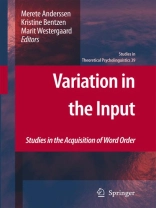The topic of variation in language has received considerable attention in the field of general linguistics in recent years. This includes research on linguistic micro-variation that is dependent on fine distinctions in syntax and information structure. However, relatively little work has been done on how this variation is acquired. This book focuses on how different types of variation are expressed in the input and how this is acquired by young children. The collection of papers includes studies of the acquisition of variation in a number of different languages, including English, German, Greek, Italian, Korean, Norwegian, Swiss German, Ukrainian, and American Sign Language. Different kinds of linguistic variation are considered, ranging from pure word order variation to optionally doubly filled COMPs and the resolution of scopal ambiguities. In addition, papers in the volume deal with the extreme case of variation found in bilingual acquisition.
Tabela de Conteúdo
Introduction, Merete Anderssen, Kristine Bentzen and Marit Westergaard.- Optional Illusions, Andrea Gualmini.- Optional Doubly-filled Complementizers (DFCs) in Wh-complements in Child and Adult Swiss German, Manuela Schönenberger.- The Acquisitionof Adjectival Ordering in Italian, Anna Cardinaletti and Giuliana Giusti.- Input Factors in Early Verb Acquisition: Do Word Frequency and Word Order Variability of Verbs Matter? Anja Kielburg an Petra Schultz.- Word Order in the Development of Dative Constructions: A Comparison of Cantonese and English, Chloe Chenjie Gu.- Using Early ASL Word Order to Shed Light on Word Order Variabiltiy in Sign Language, Deborah Chen Pichler.- Variable Word Order in Child Greek, Dina Kapetangianni.- Optional Scrambling is not Random: Evidence from English-Ukrainian Acquisition, Roksolana Mykhaylyk and Heejeong Ko.- The Acquisition of Apparent Optionality: The Word Order in Subject-and Object Shift Constructions in Norwegian, Merete Anderssen, Kristine Bentzen, Yulia Rodina and Marit Westergaard.












